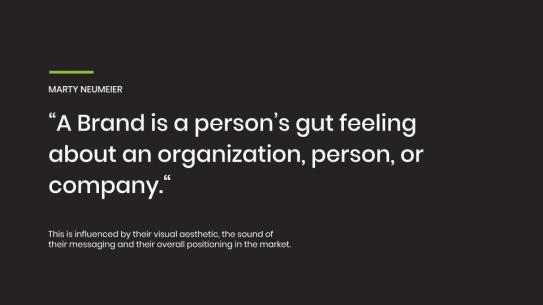What exactly is “branding”?
The word “brand” seems like a loaded word. You may think of brand development as a minefield of confusion, time, and money primed and ready to explode at any moment. But is it really?
Branding can be challenging but by taking the right steps you’ll be navigating your way to success and positioning your company as the hero in your market.
“SO WHAT IS IT!?”
Your brand is your promise to your customers. It tells them what they can expect from your products and services, and it separates you and your offerings from your competitors’. Your brand should be derived from who you are, who you want to be and who people perceive you to be.
Marty Nuemeir puts it even more simply.

Here are some simple steps to get you moving forward.
Define your Brand
The most tricky part of your journey is the journey of business self-discovery.
Before you create your brand you must first define your brand. It’s safe to say that it is the most soul searching step.
At Kelp Creative, to help teams tackle product and marketing challenges — we decided to put the brand exercises into a sprint-like process that any team can use. And the best part is: We squeezed it all onto 1 editable document that you can complete with your team in just a few short hours. It’s simple.
Brand exercises make big decisions easier
Clearly define the following to focus your brand:
- Who you are. What is your companies motivation?
- Company mission statement & Tagline
- 20-Year Roadmap: helps you think long-term.
- Your brand relative to others:
- The attitude of your brand
- Competitive landscape
- Who is our target audience
- Do your research. Learn the needs, habits, and desires of your current and prospective customers. And don’t rely on what you think they think. Know what they think.
Create the logo and Color Scheme
Color Scheme
First, let’s talk about color schemes. Though this may not seem like a super important decision for your brand; let me assure you that it is. Why? The human mind is extremely responsive to visual stimuli, which most of us already know. However, colors play a major contributor in this response, which you may or may not have known.
Each and every color will affect your brand differently as there are underlying messages behind each. The shade and tone of your color will affect your brand as well.
Meanings associated with differing colors:
- Pink: Feminine, Love, Tranquil, Beauty
- Red: Power, Passion, Vigor, Joy
- Orange: Health, Energy, Warmth, Excitement, Creativity
- Green: Nature, Soothing, Money, Endurance, Ambition, Completion
- Blue: Peace, Loyal, Clean, Trust, Science, Security
- Purple: Magic, Creativity, Royalty
- White: Purity, Cleanliness, Simplicity
- Black: Power, Sophistication
- Brown: Rural, Outdoors, Masculine
- Gold: “ooooo, you fancy!”
The Psychology of Color (And What It Means For Your Brand)
The Logo
You need to take ample time when creating your logo. Your company’s logo is a crucial piece in creating an effective brand. Think of your logo as your company’s identity. Your logo is what your audience will learn to associate with your company and its services or products.
When creating your logo, think long term. A good question to ask yourself is, ‘what logo would I like to see my company have in 10 years?’
You also want to determine how you are going to use your logo. Are you going to use it online, on billboards, stationery, vehicles, custom cardboard displays, etc? You want to create a logo that is adaptable to each and every possible way you plan to use it.
Integrate the ‘Brand’
Your brand is now ready to be integrated into every aspect of your company. Small businesses have a leg up in this area because with fewer employees comes the opportunity of being more personable with your audience.
Proper training of your staff will ensure that everyone is on the same page with the brand. Why is this important? I’ll explain using the example of a cleaning services business. If the business is trying to portray their brand as being ‘professional’ and ‘clean’, then an employee who is wearing ‘dirty’ or ‘inappropriate’ clothing will confuse your audience. Proper training of your employees will considerably help with any of these issues.
Be Consistent and Authentic
Lastly, but very importantly, make sure every communication you send out in regards to your company is consistent and in line with the brand you have created. A confusing brand will deter rather than attract your audience.
Conclusion
An effective brand strategy gives you a powerful edge in an ever-increasing, competitive market. Large or small, retail or B2B, branding is one of the most important aspects of any business. Follow the steps above to create a brand that envelops the essence of your company and reap the rewards that come along with it.




